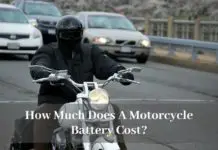
The Amp rating helps one to know just what type of charger they should use for recharging their motorcycle battery. The amp varies from one specific battery to another.
Is it possible for you to know the Amps of your motorcycle battery? Yes, You can know the amps of their motorcycle battery so that they know just how to charge it and avoid a situation of overcharging.
How many Amps is a Motorcycle Battery? The Amps is a battery depends on the type of battery you have. some might be greater than others. The user manual should be able to indicate this clearly.
How You Should Recharge Your Motorcycle Battery Correctly
Recharging the motorcycle battery should be done with utmost care as possible to avoid ruining your battery. A car battery charger might overcharge the battery and might even cause its premature death.
It is advisable that a motorcycle battery should be charged with a one-tenth of its rating in amp hours. This is to say that if you have a 30-amp motorcycle battery, it should be charged with a charger that should produce s amps for ten hours. Instead of a car battery charger, it is recommended that you make use of a trickle charger as it supplies Amps an optimum level thus allowing the battery to recharge quite comfortably.
In the case that a mistake is done and the battery is overcharged, some complications begin to arise. For starters, the electrolyte will begin to overheat and this is not a pleasant sign. In a worst case scenario, the battery might even blow up entirely. This is caused by excess hydrogen escaping from the battery and then igniting.
When charging you need to be on the lookout as things could turn to messy. If the battery gets heated up, swells or you begin to see smoke, you should disconnect the charger as this means that something is amiss.
Cold Cranking Amps
The CCA is used to describe the amps that a battery can give when at a 0-degrees Fahrenheit temperature reading for a time interval of thirty seconds. This is done as the battery does not drop beyond the 7.2 volts’ level.
This is usually an indicator of the performance of a battery when under load while at a low temperature. Needless to say, when a battery’s CCA is higher than another, it will start quicker.
Battery Amp Hour Rating
This term is used to describe how long your motorcycle battery is able to last if subjected to a fixed discharge rate. In the case of a small one, the Amp hour rating is calculated over a ten-hour interval. Take the example of an 18 Amp-Hour rating, this means that the battery in question is able to discharge 1.8 amps for ten hours.
When the Amp Hour Rating is combined with the Cold Cranking Amps, one can tell the performance of a specific battery. When both readings are fairly high, then the motorcycle battery is a good one.
Maintaining the Motorcycle Battery Charge
A normal well-maintained motorcycle battery should be able to last four years or so. Some batteries get to this point while others may not even be useful by the end of the second year. Such types of battery react in this way because of poor maintenance by their owners.
For your battery to last long enough and be reliable in its lifetime, you do not need to pay too much attention on it. all that is needed is regular basic care and it will be okay.
For starters, a clean motorcycle battery is a healthy battery. Dirt on the battery makes it prone to short circuiting that will damage the battery completely. Shorting also causes the battery to drain itself, and this can occur without you noticing. A rag damped in a solution of baking soda and water does the trick.
Is Your Motorcycle Battery in Good Condition or Not?
If you keep on experiencing issues with your motorcycle battery, there is need to worry. It might be because of a maintenance practice you overlooked or something. It might not always indicate that your battery is altogether bad, as their might be other issues causing the headaches. What you have to do is conduct a series of checks to see what is the root cause of the battery complications, the checks include:
1. Check on the Battery
Having a look at the parts of the battery for damage. This can be done by looking at the terminals, checking for bumps or even leaking from the battery. This will help prevent cases such as short circuiting that arises from damaged terminals while a bulge on the surface of the battery means that the battery has been overcharged.
2. Voltage Reading
A battery that is in good working condition has a voltage reading of 12 volts if not more. A significantly lower voltage than this might mean that the battery has some issues. A zero reading indicates a short in the battery.
Related Article: How Many Volts Are On A Motorcycle Battery?
3. Load Test the Motorcycle Battery
This can be done in any motor sop or garage. You can even do this at home by using a digital voltmeter and can be done effectively if the battery is fully charged. If yours is a health battery, the load should range from 9 to 10.5 volts. One sign for a battery with issues is that it will begin to hold at this point and then start dropping.
The terminals are another point that need to be given regular attention. They not only have to be clean, but should be dry and tightly connected onto the battery. However, not too tight as this will cause secondary damages on the battery.
In the case of a wet cell battery, regular topping with distilled water is necessary. This is for the electrolyte whenever it drops below a certain level after being in use. It is also advisable to keep the motorcycle battery in a tender if you do not use it often. This will maintain the battery to full charge or close enough which prolongs its lifetime.





